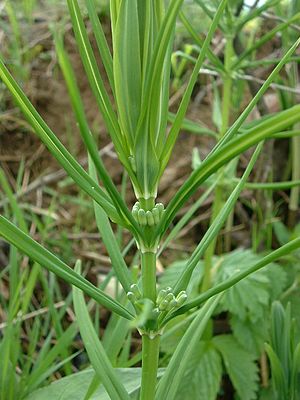Note: This is a project under development. The articles on this wiki are just being initiated and broadly incomplete. You can Help creating new pages.
Polygonatum verticillatum
Polygonatum verticillatum is a perennial plant that can grow up to 1.20 metres tall. It is harvested from the wild for local use as a food.
Uses
Parts Used
Chemical Composition
It contains 3 homoisoflavonoids, including a new compound, Dihydroxy‐3‐(4‐methoxybenzyl)‐8‐methyl chroman‐4‐one, together with two known compounds, Dihydroxy‐3‐(2‐hydroxy‐4‐methoxybenzyl)‐8‐methylchroman‐4‐one and Dihydroxy‐3‐(2‐hydroxy‐4‐methoxybenzyl)‐chroman‐4‐one.[2]
Common names
| Language | Common name |
|---|---|
| Kannada | |
| Hindi | |
| Malayalam | |
| Tamil | |
| Telugu | |
| Marathi | |
| Gujarathi | |
| Punjabi | |
| Kashmiri | |
| Sanskrit | |
| English |
Properties
Reference: Dravya - Substance, Rasa - Taste, Guna - Qualities, Veerya - Potency, Vipaka - Post-digesion effect, Karma - Pharmacological activity, Prabhava - Therepeutics.
Dravya
Rasa
Guna
Veerya
Vipaka
Karma
Prabhava
Habit
Identification
Leaf
| Kind | Shape | Feature |
|---|---|---|
Flower
| Type | Size | Color and composition | Stamen | More information |
|---|---|---|---|---|
| {{{5}}} |
Fruit
| Type | Size | Mass | Appearance | Seeds | More information |
|---|---|---|---|---|---|
Other features
List of Ayurvedic medicine in which the herb is used
Where to get the saplings
Mode of Propagation
How to plant/cultivate
Prefers a fertile humus rich moisture retentive well-drained soil in cool shade or semi-shade. Plants are intolerant of heat and drought but tolerate most other conditions.[4]
Commonly seen growing in areas
Photo Gallery
References
- ↑ Indian Medicinal Plants by C.P.Khare
- ↑ Chemical constituents
- ↑ [Morphology]
- ↑ Cultivation
External Links
- Ayurvedic Herbs known to be helpful to treat Cold
- Ayurvedic Herbs known to be helpful to treat Cough
- Herbs with Tender leaves used in medicine
- Herbs with Roots used in medicine
- Habit - Perennial
- Index of Plants which can be propagated by Seeds
- Index of Plants which can be propagated by Division in early spring
- Herbs that are commonly seen in the region of Margins of woods
- Herbs that are commonly seen in the region of Shady rocky places
- Herbs that are commonly seen in the region of Usually on acid soils
- Herbs
- Pages without herbs images





